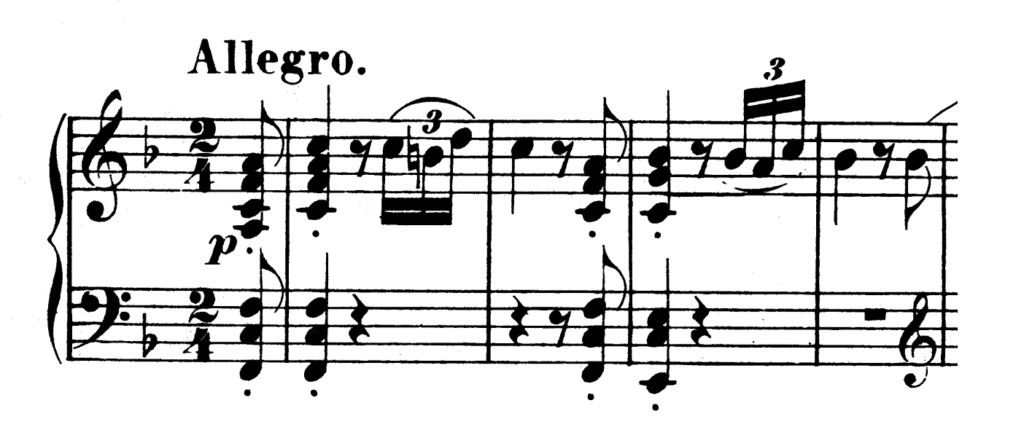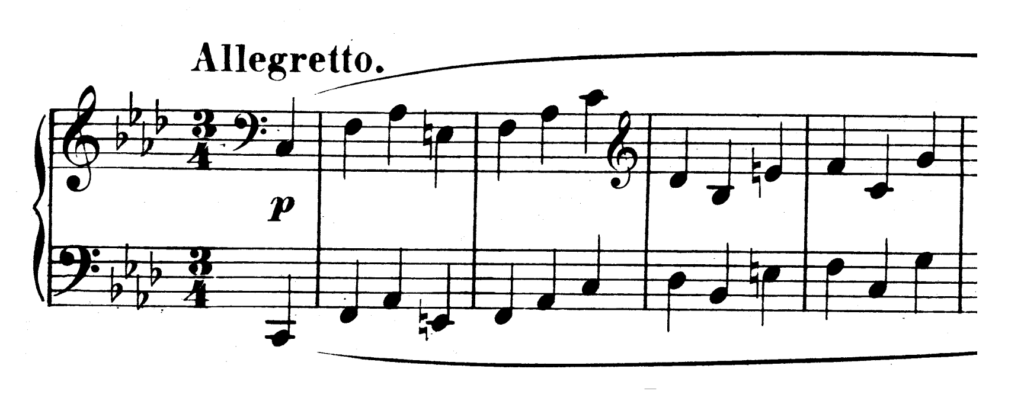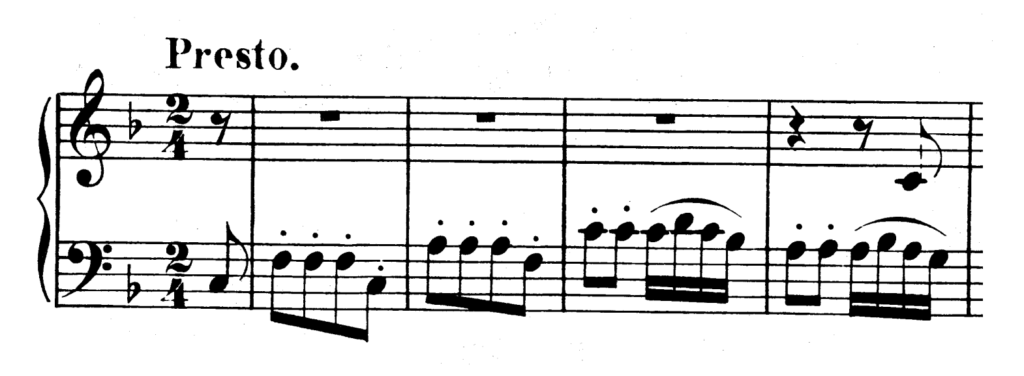Analysis
Contents
For the benefit of all pianists learning this work, we present to you a concise and easy to use analysis of Beethoven’s Piano Sonata No.6 in F major.
First Movement (Allegro)
Form: Sonata Form. F major.
EXPOSITION:
Bars 1-13: First Subject in F major (tonic). The first subject consists of twelve bars divided into three sections of four bars each.
Bars 13-19: Connecting Episode. The connecting episode begins with the first two bars of the first subject, which are repeated with the addition of D sharp (enharmonic modulation E flat to D sharp) to the harmony, producing the chord of the augmented sixth resolving on dominant A (this resolution takes place three times), an unusual chord to precede the key of C major (See Bars 17-18, third movement, Sonata No. 5).
Bars 19-56: Second Subject in C major. The second subject commences, in C major, with three four-bar phrases, the last modulating to G major, in which key there is a passage, Bars 31-37, consisting of tonic and dominant harmony, leading to a new phrase of four bars which is repeated (varied) in C minor. A chord of the diminished seventh on F sharp, Bar 47, is followed by another new four-bar phrase, Bars 48-51, after which two bars of the triplet figure (Bar 2) lead to a full close in C major.
Bars 56-67: Coda. The Coda consists of a four-bar phrase repeated with slight variations and elongations, at Bar 64 there is a curious harmonic combination of the chord of the diminished seventh (supertonic root) on inverted dominant pedal.
Double bar and repeat
DEVELOPMENT:
Bars 69-79: The last two bars of the Coda are developed, Bars 69-79.
Bars 79-97: Episode. Bars 85-89 resemble Bars 79-83 transposed into G minor; the same four bars are transposed into B flat major, Bars 93-97.
Bars 97-119: A development of the last two bars of the Coda in B flat major and B flat minor, Bar 97, and some episodal modulation, lead to the chord of the dominant of the key of D
RECAPITULATION:
Bars 120-132: First Subject in D major. The first subject is in D major instead of being in the tonic key.
Bars 133-148: Connecting Episode. The connecting episode re-appears with some modulating bats based upon the first subject, followed by the second and third sections of the first subject in the key of the tonic, Bars 140-148.
Bars 148-193: Second Subject in F major. A sequential passage formed upon the first phrase of the second subject, Bars 157-166, does not appear in the enunciation.
Bars 193-End: Coda. The final cadence of the Coda is repeated.
Double bar and repeat from Bar 69. The repetition of development and recapitulation is unusual.
Second Movement (Menuetto. Allegretto)
Form: Ternary Form. F minor.
FIRST PART:
The First Part is in Simple Binary form.
Bars 1-9: First subject in F minor (tonic) ending in A flat major.
Double bar and repeat.
Bars 10-18: Sequential passage.
Bars 18-32: First subject in original key so altered as to end in F minor (tonic).
Bars 32-40: Coda.
Double bar and repeat from Bar 10.
SECOND PART:
The Second Part is in Simple Binary form.
Bars 41-57: First subject in D flat major (tonic), ending in A flat major.
Bars 57-73: Repeated (varied).
Bars 73-82: Developmental. The development is very short; it is based on the first subject.
Bars 82-96: First subject in original key altered so as to end in D flat major (tonic).
Bars 97-121: Repeat from Bar 73.
Bars 121-127: Connecting Passage. After the second part there is a passage of six bars, Bars 122-127, leading back to the key of the Tonic.
THIRD PART:
Bars 128-End: Repetition of First Part. The First Part is repeated considerably varied. The bass of the episode, Bar 141-151, is written in quavers (eighth notes), and on the recurrence of the first subject syncopation is freely employed.
Third Movement (Presto)
Form: Sonata Form. F major.
EXPOSITION:
Bars 1-9: First Subject in F major (tonic). The first subject, consisting of four bars, leads off (in the bass) in fugal style answered at the eighth, Bar 5 (in the treble).
Bars 9-24: Connecting episode. The connecting episode, which is in the key of the dominant, begins with the first subject, upon which it is founded.
Bars 24-33: Second Subject in C major. The second subject is written upon a pedal point.
Double bar and repeat.
DEVELOPMENT:
Bars 34-87: The development refers to the first subject principally. Note the appearance of the second subject (varied) in the key of D major, Bar 71. The development ends on dominant 7th, Bar 87, succeeded by a scale passage which overlaps the entry of the first subject.
RECAPITULATION:
Bars 88-96: First Subject in original key. The first subject re-appears accompanied by a scale passage.
Bars 96-127: Connecting Episode. The connecting episode re-appears beginning with a passage of four bars (Bars 96-100) in G minor. This passage is repeated In G minor and B flat major, Bars 100-108. A brilliant variation of the first subject, beginning in B flat minor and ending on the dominant chord, leads to the re-entry of the second subject in the tonic key.
Bars 127-End: Second Subject in F major (tonic). The second subject re-appears extended, forming a short Coda.
Double bar and repeat from Bar 34. The repetition of development and recapitulation is unusual.









